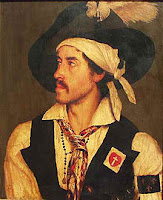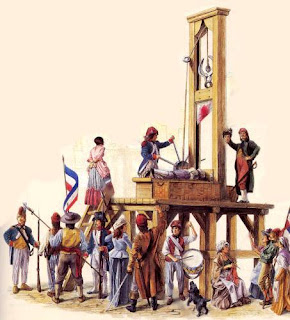War in the Vendée: Who's Who?
Bordereau, Renée (1770-1824) - Nicknamed L'Angevin, Bordereau was a French woman who disguised herself as a man and fought as a Royalist cavalier during the Vendéan insurrection. She is credited with killing numerous revolutionary soldiers and with saving hundreds of members of the clergy. Bordereau is mentioned in Marilyn Yalom's book Blood Sisters: The French Revolution in Women's Memory
Cadoudal, Georges (January 1, 1771-June 25, 1804) - Leader of the Chouans who was born in Brittany to Catholic parents. Cadoudal is also a character in The Last Cavalier
Charette, François (May 2, 1763–March 26, 1796) Of noble birth, Charette served in the French Navy, notably in the American War of Independence. A soldier and politician, he was also one of the leaders of the Vendéan Revolt. Charette was wounded during a battle with General Lazare Hoche's men, but escaped. Eventually captured near Le Logis de la Chabotterie, he was taken to Nantes where he was sentenced to death. He died heroically by firing squad. Charette is mentioned in the book The Story of the War in La Vendée and the Little Chouannerie
Cottereau, Jean aka Jean Chouan (October 30, 1757-July 18, 1794) - Much of what is written about this son of a sabot (wooden shoes) maker who grew up on a farm, near a pear orchard, in northern France is embellished romantic legend. In his early twenties, Cottereau was accused of smuggling salt, beating a man and killing a customs agent. He fled, enlisted in the infantry, was eventually captured, and spent a year in prison. Shortly before the Revolution, Cottereau began working on the grounds of an Abbey. Perhaps regular contact with holy men prompted this colorful character to repent his wicked ways, for when the Revolution errupted, Couttereau defended the clergy and the nobility. Nicknamed "chouan" (silent one), he led insurrgents through the forest and conducted what we would today call guerrilla warfare.
Després, Françoise - A woman of humble origins, educated beyond her station who dressed as a beggar to carry secret messages for the royalist army in the Vendée, often escaping arrest and inspiring her compatriots with her zeal for the counter-revolution. Després is mentioned in Marilyn Yalom's book Blood Sisters: The French Revolution in Women's Memory
du Briel, Toussaint, aka Vicomte de Pontbriand (September 2, 1776-February 2, 1844) - Colonel in the Royalist Army during the French Revolution. Awarded the Legion of Honour and the Chevalier de Saint Louis.
Saint-Hilarie, Louis Joseph Benigno Hague (December 12, 1766-1838) Colonel in the Chouannerie. Awarded the Chevalier Saint-Louis.
Tuffin, Charles Armand (April 1751-January 1793) - This Breton nobleman (also known as the Marquis de la Rouërie) was truly larger than life! A calvary officer who fought with the Americans during their War of Independence, he was brave and brash. A staunch monarchist and defender of the nobility, he is credited with being one of the founders and organizers of the Chouannerie (royalist uprising in 12 of the departments of France). See portrait of Tuffin.
Picquet, Aimé Casimir Marie Picquet aka the Chevalier du Boisguy (March 15, 1776-October 25,1839) Picquet began fighting for the royalist cause when he was barely fifteen years old, enlisting in the Royalist Army. He would serve as an aide de camp to General La Rouërie and fight in numerous battles. At seventeen, he was made a leader in the Chouannerie. At nineteen, he was promoted to general. Because of his youth and smaller stature, he was nicknamed "the little general". in 1800, he was the last General of the Chouannerie to surrender. He was awareded the Legion of Honour and the Order of Saint Louis. See portrait of Picquet.
Pontavice, Louis-Anne du (1768-1793) - Pontavice was the cousin of the Marquis de la Rouërie, the organizer of the Breton Associating/Conspiracy (a counter-revolutionary plot to return Brittany to the monarchy) who was accused of being a Vendean Conspirator and arrested on March 15, 1793 and imprisoned in the Abbaye. After evidence surfaced (bills for traveling expenses incurred by royalist sympathisers), he was sentenced to death. Read the last letter of Louis-Anne du Pontavice.
Vergier, Henri du, aka Comte de La Rochejaquelein (August 30, 1772-January 28, 1794) - This dashing, extremely brave nobleman was the youngest general of the Royalist Vendéan insurrection during the French Revolution. Born in the Château de la Durbellière near Châtillon, La Rochejaquelein fought for the first time defending the royal family at the Tuileries Palace on the October 10,1792, as an officer of the Constitutional Guard of King Louis XVI. He fought several battles against the revolutionary army. Read more about this brave soldier.
The Revolutionaries:
Beysser, Jean-Michel (November 4, 1753-April 13, 1794) This French general defeated the Vendéens in a battle in June 1793. On September 17, 1793, he was then defeated by the Vendéens at the Battle of Montaigu. For his failures, and suspicions of treason, he was arrested on October 2, 1793 and imprisoned in the Prison de l'Abbaye. He appeared before the Revolutionary Tribunal and was condemned to death March 24, 1794
Canclaux, Jean Baptiste Camille de Canclaux (August 2, 1740-December 27, 1817) - From 1791-1792, this general in the French Army was tasked with suppressing insurgents in Brittany. In 1793, the National Convention named him commander of the armée de l'Ouest. He led his soldiers in battle against the Vendéen army, coming head to head with General Charette at the battle of Montaigu and again at Mortagne-sur-Sèvre.
Carrier, Jean Baptiste (1756- December 16, 1794) - Jean-Baptiste Carrier was a Revolutionary commander who employed brutal tactics in dealing with counter-revolutionaries. In Nantes, he disposed of Vendéean prisoners-of-war in a horrifically efficient form of mass execution. He bound naked men, women, and children together, placed them in specially designed flat-bottomed boats, towed them out to the middle of the river Loire and then sunk the boats. These mass drownings were called the "noyades" and were the basis for Leah Marie Brown's novel, Scarlet Ribbons. See Carrier's portrait.

Fouché, Joseph (May 21, 1759-December 25, 1820) - Born in Nantes, he received an excellent education, took minor religious orders, and became a teacher. During the Revolution, he renounced his religious orders and was elected to the National Convention. Working for that body, he voted for the death of Louis XVI and orchestrated the murder of thousands of priests, nuns, and noblemen. He was particularly brutal to the people of the Vendée. Clever and unctuous, Fouché managed to survive the tumultuous years of the Revolution by shifting his alliances to suit the climate. He would go on to serve as Napoleon's Minister of Police, where he would have prominent members of society followed and keep meticulous notes on many citizens.
d'Herbois, Jean-Marie Collot aka Collot (June 19, 1749-June 8, 1796) - A French actor and playwright. An ardent revolutionary, he became a member of the Committee of Public Safety during the Reign of Terror. He is credited with saving Madame Tussaud from the guillotine, but also with having administered the execution of more than 2,000 people in the city of Lyon. He worked side-by-side with Fouché. He once remarked, "The rights of man are made,not for counter-revolutionaries but only for sans-culottes."
Hoche, Lazare (June 24, 1768–September 19, 1797) - Hoche was was a French soldier who rose to be general of the Revolutionary army. A fierce soldier and shrewd commander, he fought in several major battles and took part in the defense of Dunkirk. He died of tuberculosis (though some suspected he had been poisoned) and was buried in a fort on the Rhine. Hoche is the villain in Leah Marie Brown's novel, Silence in the Mist. See Hoche's portrait.
Kléber, Jean Baptiste (March 9, 1753–June 14, 1800) - Born in Strasbourg, Kléber was a general during the French Revolutionary Wars. He was integral to the supression of the Vendéans, defeating their armies at Le Mans and Savenay. Following the battle of Le Mans, he actively pursued the counter-revolutionary leader,Comte de la Rochejaquelein, resulting in that man's death. He would go on to serve as one of Napoleon's most trusted generals.
Parein, Mathieu (December 1755-May 25, 1831) - A lawyer who presided over the Revolutionary Tribunal in the Vendée. He was also in charge of a Temporary Commission set up in Lyon to reinforce revolutionary justice. Working alongside Fouché, he helped to dismantle parts of the city and murder thousands of men, women and children.
Rossignol, Jean Antoine (November 7, 1759-April 27, 1802) - This incompetent, immoral man would serve the Republic in various capacities throughout the revolution. In 1793, he was appointed Lieutenant-colonel of the gendarmerie in the Vendée and then the commander-in-chief of the armée de l'Ouest. After engaging in and encouraging looting, he was removed from his office. Later reinstalled through the machinations of Danton, he would become the commander in chief of the armée des côtes de Brest, armée de l'Ouest and armée des côtes de Cherbourg.
Verdier, Jean-Antoine (May 2, 1767—1839) - Born in Toulouse, Verdier enlisted into the Régiment de la Fère on February 18, 1785. He served as Aide-de-camp to Augereau in 1792 with the army of the Eastern Pyrenees. in September 1795, he was promoted to brigadier general.








With such colorful and powerful characters, a great epic movie could be made...unless there already is one...is there? This such an interesting part of French history that many people don't know about, thank you for bringing it to light :)
ReplyDeleteWhat a great resource your blog is- especially this little known topic! I agree, Wine and Cork, that this is inspiration for a movie. I think Mel Gibson would east this up! But did you know that there is a family film just released about the war of the Vendée? The War of the Vendée family film
ReplyDeleteThank you very much. I did not know about the film, but shall look at it.
DeleteYou are generous to share your knowledge with so many. Thank you for this blog. You should write a book about all of these facts. I would buy it.
ReplyDeleteWhat a lovely thing to say! Merci beaucoup! Actually, I am writing a book about 18th Century Tidbits. I am more than halfway finished and looking for an editor who might be interested.
Delete